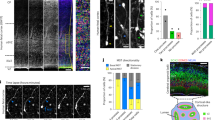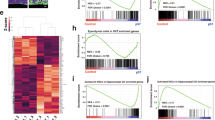Abstract
Stem cell persistence into adulthood requires self-renewal from early developmental stages. In the developing mouse brain, only apical progenitors located at the ventricle are self-renewing, whereas basal progenitors gradually deplete. However, nothing is known about the mechanisms regulating the fundamental difference between these progenitors. Here we show that the conditional deletion of the small Rho-GTPase cdc42 at different stages of neurogenesis in mouse telencephalon results in an immediate increase in basal mitoses. Whereas cdc42-deficient progenitors have normal cell cycle length, orientation of cell division and basement membrane contact, the apical location of the Par complex and adherens junctions are gradually lost, leading to an increasing failure of apically directed interkinetic nuclear migration. These cells then undergo mitoses at basal positions and acquire the fate of basal progenitors. Thus, cdc42 has a crucial role at the apical pole of progenitors, thereby regulating the position of mitoses and cell fate.
This is a preview of subscription content, access via your institution
Access options
Subscribe to this journal
Receive 12 print issues and online access
$209.00 per year
only $17.42 per issue
Buy this article
- Purchase on Springer Link
- Instant access to full article PDF
Prices may be subject to local taxes which are calculated during checkout








Similar content being viewed by others
References
Smart, I.H. A pilot study of cell production by the ganglionic eminences of the developing mouse brain. J. Anat. 121, 71–84 (1976).
Haubensak, W., Attardo, A., Denk, W. & Huttner, W.B. Neurons arise in the basal neuroepithelium of the early mammalian telencephalon: a major site of neurogenesis. Proc. Natl. Acad. Sci. USA 101, 3196–3201 (2004).
Miyata, T. et al. Asymmetric production of surface-dividing and non-surface-dividing cortical progenitor cells. Development 131, 3133–3145 (2004).
Noctor, S.C., Martinez-Cerdeno, V., Ivic, L. & Kriegstein, A.R. Cortical neurons arise in symmetric and asymmetric division zones and migrate through specific phases. Nat. Neurosci. 7, 136–144 (2004).
Wu, S.X. et al. Pyramidal neurons of upper cortical layers generated by NEX-positive progenitor cells in the subventricular zone. Proc. Natl. Acad. Sci. USA 102, 17172–17177 (2005).
Götz, M. & Huttner, W.B. The cell biology of neurogenesis. Nat. Rev. Mol. Cell Biol. 6, 777–788 (2005).
Sun, Y., Goderie, S.K. & Temple, S. Asymmetric distribution of EGFR receptor during mitosis generates diverse CNS progenitor cells. Neuron 45, 873–886 (2005).
Sauer, F.C. Mitosis in the neural tube. J. Comp. Neurol. 62, 377–405 (1935).
Tramontin, A.D., Garcia-Verdugo, J.M., Lim, D.A. & Alvarez-Buylla, A. Postnatal development of radial glia and the ventricular zone (VZ): a continuum of the neural stem cell compartment. Cereb. Cortex 13, 580–587 (2003).
Zhang, R. et al. Stroke transiently increases subventricular zone cell division from asymmetric to symmetric and increases neuronal differentiation in the adult rat. J. Neurosci. 24, 5810–5815 (2004).
Alvarez-Buylla, A., Garcia-Verdugo, J.M. & Tramontin, A.D. A unified hypothesis on the lineage of neural stem cells. Nat. Rev. Neurosci. 2, 287–293 (2001).
Englund, C. et al. Pax6, Tbr2, and Tbr1 are expressed sequentially by radial glia, intermediate progenitor cells, and postmitotic neurons in developing neocortex. J. Neurosci. 25, 247–251 (2005).
Zimmer, C., Tiveron, M.C., Bodmer, R. & Cremer, H. Dynamics of Cux2 expression suggests that an early pool of SVZ precursors is fated to become upper cortical layer neurons. Cereb. Cortex 14, 1408–1420 (2004).
Smart, I.H., Dehay, C., Giroud, P., Berland, M. & Kennedy, H. Unique morphological features of the proliferative zones and postmitotic compartments of the neural epithelium giving rise to striate and extrastriate cortex in the monkey. Cereb. Cortex 12, 37–53 (2002).
Lukaszewicz, A. et al. G1 phase regulation, area-specific cell cycle control, and cytoarchitectonics in the primate cortex. Neuron 47, 353–364 (2005).
Manabe, N. et al. Association of ASIP/mPAR-3 with adherens junctions of mouse neuroepithelial cells. Dev. Dyn. 225, 61–69 (2002).
Hutterer, A., Betschinger, J., Petronczki, M. & Knoblich, J.A. Sequential roles of Cdc42, Par-6, aPKC, and Lgl in the establishment of epithelial polarity during Drosophila embryogenesis. Dev. Cell 6, 845–854 (2004).
Etienne-Manneville, S., Manneville, J.B., Nicholls, S., Ferenczi, M.A. & Hall, A. Cdc42 and Par6-PKCzeta regulate the spatially localized association of Dlg1 and APC to control cell polarization. J. Cell Biol. 170, 895–901 (2005).
Lin, D. et al. A mammalian PAR-3-PAR-6 complex implicated in Cdc42/Rac1 and aPKC signalling and cell polarity. Nat. Cell Biol. 2, 540–547 (2000).
Schaar, B.T. & McConnell, S.K. Cytoskeletal coordination during neuronal migration. Proc. Natl. Acad. Sci. USA 102, 13652–13657 (2005).
Tsai, L.H. & Gleeson, J.G. Nucleokinesis in neuronal migration. Neuron 46, 383–388 (2005).
Govek, E.-E., Newey, S.E. & Van Aelst, L. The role of the Rho GTPases in neuronal development. Genes Dev. 19, 1–49 (2005).
Wu, X. et al. Cdc42 controls progenitor cell differentiation and beta-catenin turnover in skin. Genes Dev. 20, 571–585 (2006).
Iwasato, T. et al. Cortex-restricted disruption of NMDAR1 impairs neuronal patterns in the barrel cortex. Nature 406, 726–731 (2000).
Haubst, N. et al. Molecular dissection of Pax6 function: the specific roles of the paired domain and homeodomain in brain development. Development 131, 6131–6140 (2004).
Miyata, T., Kawaguchi, A., Okano, H. & Ogawa, M. Asymmetric inheritance of radial glial fibers by cortical neurons. Neuron 31, 727–741 (2001).
Noctor, S.C., Flint, A.C., Weissman, T.A., Dammerman, R.S. & Kriegstein, A.R. Neurons derived from radial glial cells establish radial units in neocortex. Nature 409, 714–720 (2001).
Calegari, F., Haubensak, W., Haffner, C. & Huttner, W.B. Selective lengthening of the cell cycle in the neurogenic subpopulation of neural progenitor cells during mouse brain development. J. Neurosci. 25, 6533–6538 (2005).
Palazzo, A.F. et al. Cdc42, dynein, and dynactin regulate MTOC reorientation independent of Rho-regulated microtubule stabilization. Curr. Biol. 11, 1536–1541 (2001).
Olson, M.F., Ashworth, A. & Hall, A. An essential role for Rho, Rac, and Cdc42 GTPases in cell cycle progression through G1. Science 269, 1270–1272 (1995).
Gomes, E.R., Jani, S. & Gundersen, G.G. Nuclear movement regulated by Cdc42, MRCK, myosin, and actin flow establishes MTOC polarization in migrating cells. Cell 121, 451–463 (2005).
Heins, N. et al. Emx2 promotes symmetric cell divisions and a multipotential fate in precursors from the cerebral cortex. Mol. Cell. Neurosci. 18, 485–502 (2001).
Kosodo, Y. et al. Asymmetric distribution of the apical plasma membrane during neurogenic divisions of mammalian neuroepithelial cells. EMBO J. 23, 2314–2324 (2004).
Chenn, A. & McConnell, S.K. Cleavage orientation and the asymmetric inheritance of Notch1 immunoreactivity in mammalian neurogenesis. Cell 82, 631–641 (1995).
Takahashi, T., Nowakowski, R.S. & Caviness, V.S. The cell cycle of the pseudostratified ventricular epithelium of the embryonic murine cerebral wall. J. Neurosci. 15, 6046–6057 (1995).
Joberty, G., Petersen, C., Gao, L. & Macara, I.G. The cell-polarity protein Par6 links Par3 and atypical protein kinase C to Cdc42. Nat. Cell Biol. 2, 531–539 (2000).
Weigmann, A., Corbeil, D., Hellwig, A. & Huttner, W.B. Prominin, a novel microvilli-specific polytopic membrane protein of the apical surface of epithelial cells, is targeted to plasmalemmal protrusions of non-epithelial cells. Proc. Natl. Acad. Sci. USA 94, 12425–12430 (1997).
Macara, I.G. Parsing the polarity code. Nat. Rev. Mol. Cell Biol. 5, 220–231 (2004).
Eto, K. & Osumi-Yamashita, N. Whole embryo culture and the study of postimplantation mammalian development. Dev. Growth Differ. 37, 123–132 (1995).
Gotz, M., Stoykova, A. & Gruss, P. Pax6 controls radial glia differentiation in the cerebral cortex. Neuron 21, 1031–1044 (1998).
Tarabykin, V., Stoykova, A., Usman, N. & Gruss, P. Cortical upper layer neurons derive from the subventricular zone as indicated by Svet1 gene expression. Development 128, 1983–1993 (2001).
Schuurmans, C. et al. Sequential phases of cortical specification involve Neurogenin-dependent and -independent pathways. EMBO J. 23, 2892–2902 (2004).
Jaffe, A.B. & Hall, A. RHO GTPases: biochemistry and biology. Annu. Rev. Cell Dev. Biol. 21, 247–269 (2005).
Czuchra, A. et al. Cdc42 is not essential for filopodium formation, directed migration, cell polarization, and mitosis in fibroblastoid cells. Mol. Biol. Cell 16, 4473–4484 (2005).
Mertens, A.E., Rygiel, T.P., Olivo, C., van der Kammen, R. & Collard, J.G. The Rac activator Tiam1 controls tight junction biogenesis in keratinocytes through binding to and activation of the Par polarity complex. J. Cell Biol. 170, 1029–1037 (2005).
Kholmanskikh, S.S. et al. Calcium-dependent interaction of Lis1 with IQGAP1 and Cdc42 promotes neuronal motility. Nat. Neurosci. 9, 50–57 (2006).
Machon, O., van den Bout, C.J., Backman, M., Kemler, R. & Krauss, S. Role of [beta]-catenin in the developing cortical and hippocampal neuroepithelium. Neuroscience 122, 129–143 (2003).
Hatakeyama, J. Hes genes regulate size, shape and histogenesis of the nervous system by control of the timing of neural stem cell differentiation. Development 131, 5539–5550 (2004).
Li, H.S. et al. Inactivation of Numb and Numblike in embryonic dorsal forebrain impairs neurogenesis and disrupts cortical morphogenesis. Neuron 40, 1105–1118 (2003).
Imai, F. et al. Inactivation of aPKClambda results in the loss of adherens junctions in neuroepithelial cells without affecting neurogenesis in mouse neocortex. Development 133, 1735–1744 (2006).
Acknowledgements
We thank R.F. Hevner, D. Lin, D.J. Anderson, C. Schuurmans and V. Tarabykin for probes and antibodies; Y.-A. Barde for helpful comments on the manuscript; and M. Körbs, A. Bust, Z. Kirejczyk and B. DelGrande for excellent technical and secretarial assistance. M.G. is supported by the German Research Foundation. S.C. is recipient of a Marco Polo Fellowship.
Author information
Authors and Affiliations
Contributions
S.C. did most of the experimental work. A.A. did the electroporation analysis. X.W. and C.B. generated the floxed cdc42 mice. T.I. and S.I. generated the Emx1::cre mice. M.W.-B. did the electronmicroscopic analysis. H.M.E., M.A.R. and T.T.S. taught and helped with the time-lapse analysis. W.B.H. was involved in writing the manuscript and designing experiments. M.G. designed the entire project, directed most of the experiments and wrote the manuscript together with S.C.
Corresponding author
Ethics declarations
Competing interests
The authors declare no competing financial interests.
Supplementary information
Supplementary Fig. 1
Phenotype of the adult cdc42-deficient cortex. (PDF 391 kb)
Supplementary Fig. 2
Analysis of orientation of cell division and cell cycle. (PDF 75 kb)
Supplementary Fig. 3
Distribution pattern of BrdU-labeled cells after S-phase. (PDF 184 kb)
Supplementary Fig. 4
Analysis of basal lamina, radial processes and adherens junctions after cdc42 deletion at E10. (PDF 843 kb)
Supplementary Video 1
Example 1 of a cortical neuroepithelial cell isolated at embryonic day 12 from cdc42-deficient cortex exhibiting interkinetic nuclear migration in vitro. See Methods for details. (AVI 958 kb)
Supplementary Video 2
Example 2 of a cortical neuroepithelial cell isolated at embryonic day 12 from cdc42-deficient cortex exhibiting interkinetic nuclear migration in vitro. See Methods for details. (AVI 2536 kb)
Rights and permissions
About this article
Cite this article
Cappello, S., Attardo, A., Wu, X. et al. The Rho-GTPase cdc42 regulates neural progenitor fate at the apical surface. Nat Neurosci 9, 1099–1107 (2006). https://doi.org/10.1038/nn1744
Received:
Accepted:
Published:
Issue Date:
DOI: https://doi.org/10.1038/nn1744
This article is cited by
-
PAK3 activation promotes the tangential to radial migration switch of cortical interneurons by increasing leading process dynamics and disrupting cell polarity
Molecular Psychiatry (2024)
-
Novel role of the synaptic scaffold protein Dlgap4 in ventricular surface integrity and neuronal migration during cortical development
Nature Communications (2022)
-
Neurodevelopmental signatures of narcotic and neuropsychiatric risk factors in 3D human-derived forebrain organoids
Molecular Psychiatry (2021)
-
Altered cleavage plane orientation with increased genomic aneuploidy produced by receptor-mediated lysophosphatidic acid (LPA) signaling in mouse cerebral cortical neural progenitor cells
Molecular Brain (2020)
-
Molecular and cellular evolution of corticogenesis in amniotes
Cellular and Molecular Life Sciences (2020)



